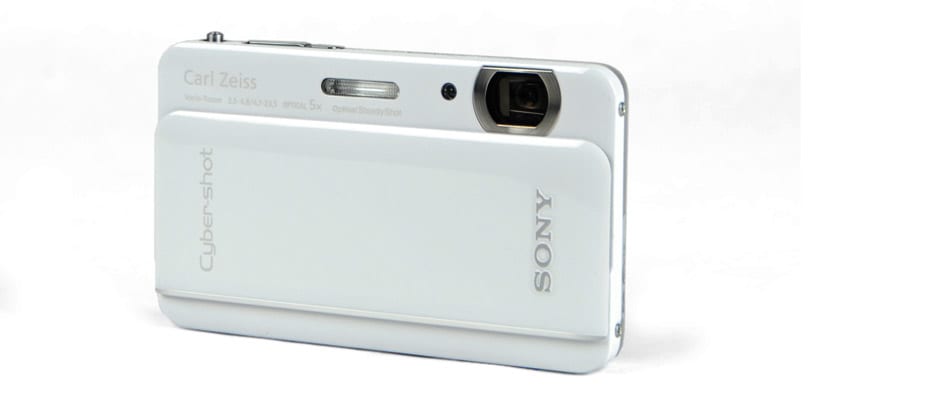Pros
Cons
Introduction
Ostentatious? Yeah, and wickedly expensive, too. Let's cut to the chase: $350 is a lot of money for a point-and-shoot. If you have any sense of value, steer clear. But if a) money is no object, b) a camera is an accessory to you, not a photographic tool, and c) by some fat chance, you don’t already have the latest iPhone (or something like it), then the TX66 actually has a handful of redeeming values. Read on.
The Sony Cyber-shot TX66 is available now for an MSRP of $349 in white, silver, pink, and violet shades.
Design & Usability
{{section_header}}{{section.name}}{{/section_header}}
This cutesy camera is one of the smallest on the market, but it’s packed with some big-time hardware.
The point of the TX66 is to look cute and to be tiny. It must be one of the absolute smallest cameras out there, but it’s still packed with some new and expensive tech; in this case, their latest Exmor R backlit CMOS sensor, weighing in at a class-leading (and wholly unnecessary) 18.2 megapixels, as well as a 3.3-inch, 1.2 million-dot OLED screen (OLED is prized over LCD for more vibrant colors, sharper contrast, and better battery life, but it’s much more expensive to manufacture). This sort of hardware doesn’t fundamentally improve the user experience compared to a camera with, say, a slightly thicker body or a regular LCD, but these components certainly lend a high-quality feel.
The lens is an all-internal, Zeiss brand piece, with optical SteadyShot stabilization, 5x optical zoom (26-130mm equivalent), and a modest f/3.5-4.8 maximum aperture. Typical of a point-and-shoot, the TX66 is built around a 1/2.3-inch sensor, but it's one of Sony’s Exmor R backside-illuminated CMOS sensors, which generally offer solid low-light performance and speedy burst shooting.
The TX66 is not rated for any kind of water resistance or shock-proofing. It doesn’t even feel like it’s built to withstand light bumps and bruises, and we somehow managed to scratch the front panel during testing. Handle it with care. If you like the design and form-factor but want something a bit hardier, check out the TX20 or TX200V instead.
{{photo_gallery "Front Photo", "Back Photo", "Sides Photo", "Top Photo", "Bottom Photo", "Lens Photo", "Lens Photo 2", "3D Lens Photo", "Media Photo", "Easy Mode Photo", "Manual Controls Photo 1", "Manual Controls Photo 2", "Zoom Photo", "Zoom Photo 2", "Ease of Use Photo", "Battery Photo", "LCD Photo 1", "LCD Photo 2", "EVF Photo 1", "EVF Photo 2", "Ports Photo 1", "Ports Photo 2", "Ports Photo 3", "Ports Photo 4", "Ports Photo 5", "Ports Photo 6", "Handling Photo 1", "Handling Photo 2", "Handling Photo 3", "Handling Photo 4", "Buttons Photo 1", "Buttons Photo 2", "Buttons Photo 3", "Box Photo"}}
Features
{{section_header}}{{section.name}}{{/section_header}}
Move along, nothing to see here...
Most of the cool features on the TX66 fall under the banners of regular hardware or shooting modes. There’s no WiFi, GPS, or optional viewfinder available here, so we’ve covered most of the extras already. For shooting modes, there are two auto settings: Intelligent Auto and Superior Auto. Program mode is offered too, though, as well as special options like iSweep Panorama, 3D-assist shooting, and Background Defocus. Picture Effects and Scene Selection round out the menu.
As it should be, the TX66 is an autofocus-only camera. Typical modes like full-frame, center, face recognition, and spot focus are here, as is the eminently useful touch-to-focus feature. Focus is speedy and fairly accurate in most lighting, but it struggles more in dim lighting and low-contrast settings.
Additionally, thanks to its backlit CMOS sensor, the TX66 is a speedy camera with a few different drive modes available, and some extra timer settings too. This Sony offers two continuous settings, high and low, as well as a single-shot setting, all of which support full-res shots. Backlit CMOS sensors have been kicking around for a few years now, so it’s not really a surprise to see speedy burst rates anymore, but the TX66 can crank out 6.67 frames per second by our measurement—not the fastest out there, but quick enough for most purposes. The buffer fills up after 10 shots. Lastly, the standard 10 second and 2 second self-timers are on hand, and face-recognition tech supports self-portrait timers for one or two people—it waits until it sees the appropriate number of faces in the frame before shooting.
Performance
{{section_header}}{{section.name}}{{/section_header}}
In typical pocket camera form, the TX66 takes photos best suited for sharing online.
At small and medium viewing sizes (think Facebook), and in just about any shooting situation, even low light, the TX66's image quality is highly satisfactory. Colors are vibrant. Shots are clean and smooth up through ISO 800, and again at ISO 6400 and 12800, thanks to a smart multi-photo composite feature, which fights noise by taking a burst of a few photos and mashing them together, resulting in a cleaner image. Up close, the pictures look more like paintings than photographs, but again, they look pretty great on a computer screen.
At larger viewing sizes, the TX66's limitations become much more obvious. Sure, photos look clean, but that's because noise reduction has buffed away fine details and textures, and the lens appears to be pretty soft too. As long as you don’t make huge prints, you won’t notice, but by that logic, this might as well just be a 10 or 12 megapixel camera—bear that in mind before you let a company woo you with a big megapixel number, like this one's 18. Sharpness is a mixed bag too. It earned a respectable score on our software-based lab tests, but on close inspection, edges looked fuzzy—a common phenomenon and evidence of artificial pixel sharpening. This software makes edges look crisper from a distance, but up close, borders appear fuzzy. Just avoid making large prints.
Conclusion
{{section_header}}{{section.name}}{{/section_header}}
The TX66 is way overpriced, and we’re not backing it.
Remember when pocket cameras were fashion accessories? That was back when MySpace was still a thing and text messages were 10 cents each. Now the style-conscious, gadget-accessory of choice is the smartphone, which tends to take good enough photos for sharing on MySp—oops, Facebook. That revelation marginalizes cameras like the TX66. It’s expensive because it’s small and it looks cool, not because it takes better photos than a $200 camera. What’s the point?
Yes, it's very slick and its 3.3-inch OLED screen looks great. The touch interface works well and it's so thin that Sony had to equip it with an undersized tripod mount (they graciously included an adapter). It’s notably smaller than pretty much any cell phone, in fact, and for sharing photos on the web, the picture quality is actually very strong, even in dark settings—yes, obviously better than a smartphone camera.
But for anyone serious about taking high-quality pictures, the TX66 falls short. Photos tend to have the texture of a watercolor painting—smooth, vibrant, but very soft. The bloated megapixel count may or may not hurt the overall photo quality—there are too many factors to say for sure—but in any case, the file sizes are unnecessarily huge: typically 5MB per photo, even up to 7MB. That’ll fill up your memory card pretty fast. Moreover, since shots are so soft at full resolution, the photos might as well be 10 or maybe 12 megapixels instead‚ saving storage space, processing time, and all the hot air from armchair analysts who love to rant about how more actually means less, in terms of megapixels.
If you already have a smartphone, just stick with that. The picture quality is probably fine, and you can share photos instantly from anywhere. If you have your heart set on a camera and you like the form factor, the ruggedized TX20 looks like more bang for the buck; at least your expensive toy can stand up to a few bumps, bruises, and days at the beach. And if you can’t live without the OLED screen, then money is obviously not a problem for you, so pony up for the TX200V, which is also ruggedized. Overall, the TX66 is a decent pocket camera with some nice features, but that doesn’t get it very far in the current camera climate.
Science Introduction
{{section_header}}{{section.name}}{{/section_header}}
The Sony Cyber-shot TX66 (MSRP $349) is a slim, slick, fashion-conscious camera. Its asking price is ramped up considerably due to its design, which houses image capturing technology that's really only suited for snapping Facebook-quality photos. Sound a little bit like your smartphone? The performance is only somewhat better, and considering the TX66's big-boy price tag and the fact that it can't make calls or go online, you'd be better off avoiding it.
Color Accuracy
{{section_header}}{{section.name}}{{/section_header}}
The TX66 has only one color mode, but it's fairly accurate.
We measured a minimum color error of 3.17 (under 3.5 is decent, and under 3.0 is excellent) and 111% saturation (anything under 90% or over 110% incurs a penalty, so the TX66 takes a small hit here). Most colors were fairly accurate, but reds were very exaggerated, and blues to a lesser extent. Color is incredibly subjective, so scoring a camera based on color accuracy can be a bit deceiving. It’s best to just look at some sample photos and decide which profile suits your personal taste.
{{photo_gallery "Science Section 1 Images"}}
Low Light
{{section_header}}{{section.name}}{{/section_header}}
By the modest expectations of point-and-shoots, the TX66 is a strong low-light performer.
The TX66's higher ISO settings are clean enough to take decent snapshots in dim situations, and the smart multi-shot composite feature that kicks in at ISOs 6400 and 12800 can pull useful photos from places that no pocket camera could’ve attempted a few years ago.
Basically, for folks who enjoy the nightlife, this camera will get the job done better than most.
{{photo_gallery "Science Section 2 Images"}}
Distortion & Detail
{{section_header}}{{section.name}}{{/section_header}}
The TX66 struggled with distortion errors along its focal range, and noise reduction software does a number on fine detail at higher ISOs.
Distortion isn’t usually a problem for point-and-shoots anymore—most of them earn a perfect score in our test. But the TX66 struggled mightily at the wide angle. We measured 2.4% barrel distortion, which is huge. The problem disappears at the middle and telephoto ranges, but the obvious warping at the wide angle drags down the score quite a bit.
As for fine detail, though the TX66 earns a solid noise score, it has no qualms about scrubbing texture to get rid of noise. The effect is pretty mild through ISO 400, but it becomes obvious at ISO 800, problematic at ISO 1600, and exaggerated at ISO 3200 and above. Any of the settings will produce a usable small snapshot, but if you plan to use photos at larger sizes, then stick with ISOs 400 and below.
{{photo_gallery "Science Section 3 Images"}}
Other Tests
{{section_header}}{{section.name}}{{/section_header}}
{{photo_gallery "Other Tests Images"}}
Meet the tester
Liam manages features and news coverage for Reviewed.com. Formerly the editor of the DigitalAdvisor network, he's covered cameras, TVs, personal electronics, and (recently) appliances. He's a native Bostonian and has played in metal bands you've never heard of.
Checking our work.
Our team is here to help you buy the best stuff and love what you own. Our writers, editors, and experts obsess over the products we cover to make sure you're confident and satisfied. Have a different opinion about something we recommend? Email us and we'll compare notes.
Shoot us an email

